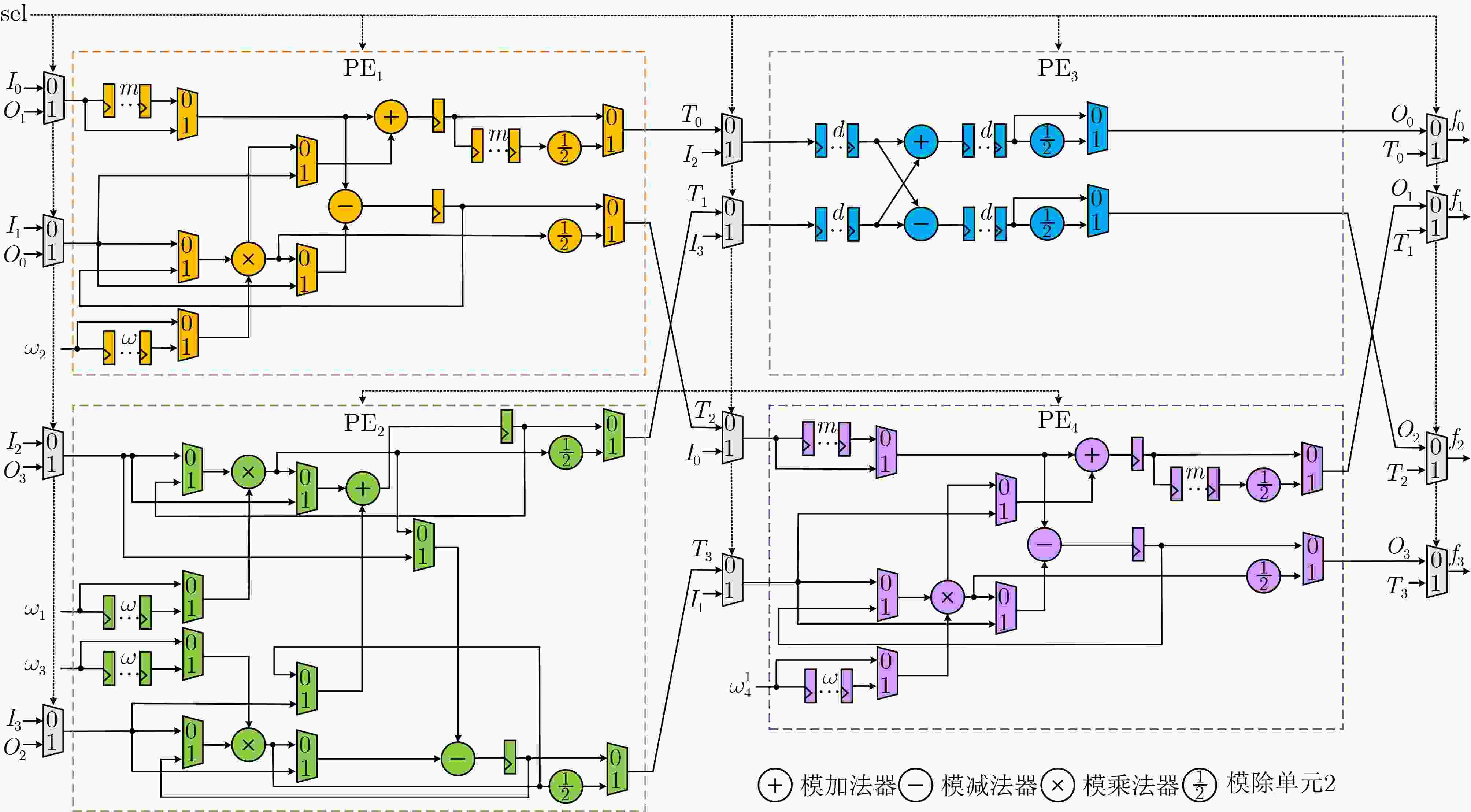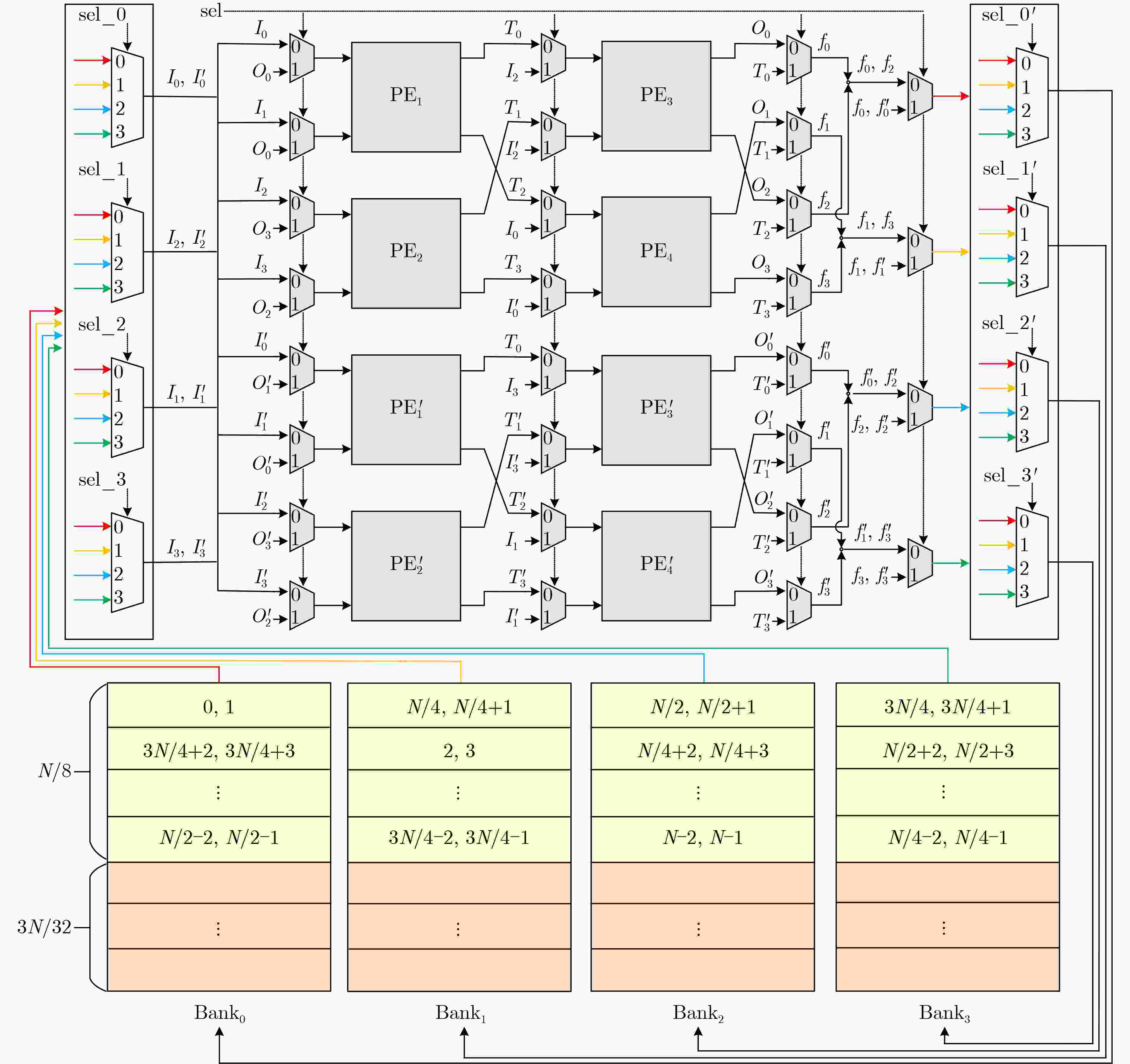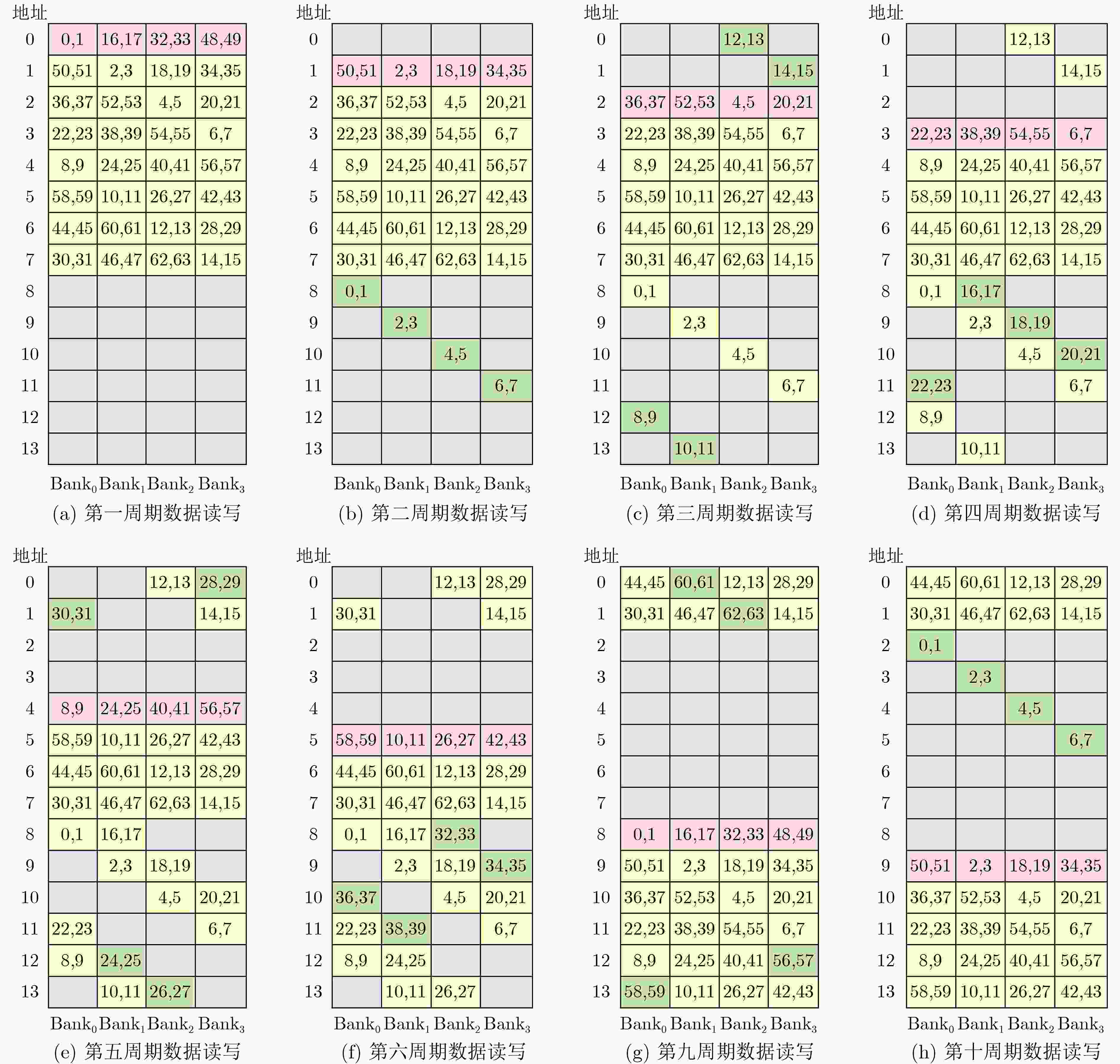High Area-efficiency Radix-4 NTT Hardware Architecture with Conflict-free Memory Access Optimization for Lattice-based Cryptography
-
摘要: 针对格基后量子密码(PQC)算法中基-2数论变换(NTT)计算效率较低以及原位计算内存访问模式复杂的问题,该文提出一种高面积效率的基-4 NTT硬件设计。首先,介绍了负包裹卷积方法的运算流程及适用条件,在此基础上提出了一种恒定几何(CG)结构的低计算复杂度基-4 NTT/INTT算法。其次,深入分析不同PQC算法中模数的共性特征,设计了基于K2-RED约简的可扩展模乘单元。最后,通过优化存储器与蝶形单元之间的数据分解与重组,提出一种基于顺序循环和阶梯循环访存的读写地址生成方案,实现了高效的无访存冲突。与传统的乒乓存储模式相比,该方案可减少12.5%的存储空间。实验结果表明,在(项数,模数位宽)分别为(256, 13)、(256, 23)和(
1024 , 14)的3种配置下,该设计的面积-时间积(ATP)较现有方案分别降低56.4%、69.8%和50.3%以上,具有更高的面积效率。Abstract:Objective With the advancement of Post-Quantum Cryptography (PQC) standardization, the efficient implementation of Number Theoretic Transform (NTT) modules has become crucial for enhancing the performance of PQC algorithms. While existing research on high-radix NTT primarily focuses on optimizing in-place computation structures and achieving configurability, it often overlooks performance bottlenecks caused by complex memory access patterns and lacks dedicated optimizations for the specific parameters of PQC algorithms. To address these challenges, this paper proposes a high area-efficiency radix-4 NTT design with a Constant-Geometry (CG) structure. The solution implements targeted optimizations for the modular multiplication unit by analyzing the common characteristics of moduli and integrating multi-level operations, while optimizing memory allocation and address generation strategies to effectively reduce memory capacity and improve data access efficiency. This paper provides an efficient solution for implementing radix-4 CG NTT in out-of-place storage, achieving conflict-free memory access. Methods At the algorithmic level, the proposed radix-4 CG NTT/INTT employs a low-complexity design and eliminates the bit-reversal operation to reduce multiplication count and computation cycles, with a correspondingly redesigned twiddle factor access mechanism. Regarding the most time-consuming modular multiplication in the radix-4 butterfly unit, the critical path is effectively shortened by integrating the multiplication with the first-stage ${\text{K}} - {\text{RED}}$ reduction and simplifying the correction logic. Furthermore, to support three parameter configurations, a scalable modular multiplication scheme is proposed by analyzing common characteristics of different moduli. At the architectural level, a strategy is employed where two coefficients are concatenated and stored at the same memory address. By designing a data decomposition and reorganization scheme, the interaction between the memory and the dual-butterfly units is efficiently managed. To efficiently achieve conflict-free memory access, a cyclic memory space reuse strategy is employed, and read and write address generation schemes based on sequential and stepped access patterns are designed, significantly reducing the required memory capacity and the complexity of control logic. Results and Discussions Experimental results on Field Programmable Gate Arrays (FPGAs) demonstrate that the proposed NTT architecture achieves high operating frequencies and low resource consumption under three parameter configurations, while also significantly improving the Area-Time Product (ATP) compared to existing designs ( Table 5 ). For the configuration with 256 terms and a modulus of7681 , it consumes2397 slices, 4 BRAMs, and 16 DSPs, achieving an operating frequency of 363 MHz, resulting in at least a 56.4% improvement in ATP. For the configuration with 256 terms and a modulus of8380417 , it consumes3760 slices, 6 BRAMs, and 16 DSPs, achieving an operating frequency of 338 MHz, resulting in at least a 69.8% improvement in ATP. For the configuration with1024 terms and a modulus of12289 , it consumes2379 slices, 4 BRAMs, and 16 DSPs, achieving an operating frequency of 357 MHz, resulting in at least a 50.3% improvement in ATP.Conclusions This paper proposes a high area-efficiency radix-4 NTT hardware architecture for lattice-based PQC algorithms. By employing a low-complexity radix-4 CG NTT/INTT and eliminating the bit-reversal operation, the latency is reduced. By analyzing the common characteristics of three specific moduli and merging partial computations, a scalable modular multiplication architecture based on ${\text{K}}{}^2 - {\text{RED}}$ reduction is designed. This paper tackles the challenges of storage space doubling and address generation complexity by efficiently reusing memory and designing address generation schemes based on sequential and stepped access patterns. Experimental results demonstrate that the proposed scheme significantly improves operating frequency and reduces resource consumption, resulting in lower ATP under three parameter configurations. However, this study only considers a dual-butterfly unit architecture. Future research should further explore architectural designs with higher degrees of parallelism to meet performance requirements for various application scenarios. -
表 1 基-4 CG NTT算法
输入:$ \mathrm{n} $$a(x) \in {R_p}$,${\varphi _{2N}} \in {\mathbb{Z}_p}$,$\omega _4^1$ 输出:$A(x) = NTT(a(x))$ (a)存储预计算的旋转因子 1. for $s = 1$ to ${\log _4}N$ do 2. $l = N{\text{/}}{4^s}$ 3. ${\omega _m} = \varphi _{2N}^l$ 4. for $j = 0$ to ${4^{s - 1}} - 1$ do 5. ROM_1.append$ [\omega _m^{2{\text{bit}} - {\text{reversed(}}j) + 1}] $ 6. ROM_2.append$[\omega _m^{2 \cdot (2{\text{bit}} - {\text{reversed(}}j) + 1)}]$ 7. ROM_3.append$[\omega _m^{3 \cdot (2{\text{bit}} - {\text{reversed(}}j) + 1)}]$ 8. end for 9. end for (b)基-4 CG NTT运算 1. for $s = 1$ to ${\log _4}N$ do 2. for $i = 0$ to $N{\text{/}}4 - 1$ do 3. ${r^{'}} = i{\rm{mod}} {4^{s - 1}}$ 4. $r = {\text{convert(}}{r^{'}}) + ({4^{s - 1}} - 1)/3$ 5. ${\omega _1} = {\text{ROM\_1[}}r{\text{]}}$ 6. ${\omega _2} = {\text{ROM}}\_2[r]$ 7. ${\omega _3} = {\text{ROM\_3[}}r{\text{]}}$ 8. ${T_0} = (a[i] + a[i + 2N/4] \cdot {\omega _2}){\rm{mod}} p$ 9. ${T_1} = (a[i] - a[i + 2N/4] \cdot {\omega _2}){\rm{mod}} p$ 10. ${T_2} = (a[i + N/4] \cdot {\omega _1} + a[i + 3N/4] \cdot {\omega _3}){\rm{mod}} p$ 11. ${T_3} = (a[i + N/4] \cdot {\omega _1} - a[i + 3N/4] \cdot {\omega _3}){\rm{mod}} p$ 12. $A[4i] = ({T_0} + {T_2}){\rm{mod}} p$ 13. $A[4i + 1] = ({T_1} + {T_3} \cdot \omega _4^1){\rm{mod}} p$ 14. $A[4i + 2] = ({T_0} - {T_2}){\rm{mod}} p$ 15. $A[4i + 3] = ({T_1} - {T_3} \cdot \omega _4^1){\rm{mod}} p$ 16. end for 17.end for 表 2 基-4 CG INTT算法
输入:$ \mathrm{n} $$A(x) \in {R_P}$,${\varphi _{2N}} \in {\mathbb{Z}_p}$,$\omega _4^1$ 输出:$a(x) = INTT(A(x))$ 1. for $s = {\log _4}N$ to 1 do 2. for $i = 0$ to $N{\text{/}}4 - 1$ do 3. ${i^{'}} = N{\text{/}}4 - 1 - i$ 4. ${r^{'}} = {i^{'}}{\rm{mod}} {4^{s - 1}}$ 5. $r = {\text{convert(}}{r^{'}}) + ({4^{s - 1}} - 1)/3$ 6. ${\omega _1} = {\text{ROM\_1}}[r]$ 7. ${\omega _2} = {\text{ROM\_2[}}r]$ 8. ${\omega _3} = {\text{ROM\_3}}[r]$ 9. ${T_0} = {2^{ - 1}} \cdot (A[4i] + A[4i + 2]){\rm{mod}} p$ 10. ${T_1} = (A[4i + 2] - A[4i]) \cdot \omega _4^1{\rm{mod}} p$ 11. ${T_2} = {2^{ - 1}} \cdot (A[4i + 1] + A[4i + 3]){\rm{mod}} p$ 12. ${T_3} = {2^{ - 1}} \cdot (A[4i + 3] - A[4i + 1]){\rm{mod}} p$ 13. $a[i] = {2^{ - 1}} \cdot ({T_0} + {T_2}){\rm{mod}} p$ 14. $a[i + N/4] = {2^{ - 1}} \cdot ({T_1} + {T_3}) \cdot {\omega _1}{\rm{mod}} p$ 15. $a[i + 2N/4] = {2^{ - 1}} \cdot ({T_2} - {T_0}) \cdot {\omega _2}{\rm{mod}} p$ 16. $a[i + 3N/4] = {2^{ - 1}} \cdot ({T_3} - {T_1}) \cdot {\omega _3}{\rm{mod}} p$ 17. end for 18.end for 表 3 K2-RED约简算法
输入:$Z \in [0,{p^2})$, $p = k \cdot {2^m} + 1$, $n = \left\lfloor {{{\log }_2}p} \right\rfloor $ 输出:${Z^{''}} = {k^2} \cdot Z{\rm{mod}} p$ 1: ${Z_l} = Z[m - 1:0]$ $ {\mathrm{Z}}_{\mathrm{l}}=\mathrm{Z}\mathrm{ }\left(\mathrm{m}\mathrm{o}\mathrm{d}{2}^{\mathrm{m}}\right) $ 2: ${Z_h} = Z[2n - 1:m]$ 3: ${Z^{'}} = k{Z_l} - {Z_h}$ 4: ${Z_l}^{'} = {Z^{'}}[m - 1:0]$ 5: ${Z_h}^{'} = {Z^{'}}[2n - m - 1:m]$ 6: ${Z^{''}} = k{Z_l}^{'} - {Z_h}^{'}$ 7: return ${Z^{''}}$ 表 4 格基PQC方案中模乘核心步骤的定量比较
Kyber v1算法 Dilithium算法 Falcon算法 $(m,k,n)$ (9,15,13) (13, 1023 ,23)(12,3,14) 两阶段K-RED约简 ${Z^{'}} = ({Z_l} \lt \lt 4) - {Z_l} - {Z_h}$${Z^{''}} = ({Z_l}^{'} \lt \lt 4) - {Z_l}^{'} - {Z_h}^{'}$ ${Z^{'}} = ({Z_l} \lt \lt 10) - {Z_l} - {Z_h}$
${Z^{''}} = ({Z_l}^{'} \lt \lt 10) - {Z_l}^{'} - {Z_h}^{'}$${Z^{'}} = ({Z_l} \lt \lt 2) - {Z_l} - {Z_h}$
${Z^{''}} = ({Z_l}^{'} \lt \lt 2) - {Z_l}^{'} - {Z_h}^{'}$修正值 ${\text{Sig}}{{\text{n}}_1}{\text{Sig}}{{\text{n}}_2} = 01$ 7681 8380417 12289 ${\text{Sig}}{{\text{n}}_1}{\text{Sig}}{{\text{n}}_2} = 10$① - 7425 - 7331841 - 12273 ${\text{Sig}}{{\text{n}}_1}{\text{Sig}}{{\text{n}}_2} = 10$② 256 1048576 16 ${\text{Sig}}{{\text{n}}_1}{\text{Sig}}{{\text{n}}_2} = 11$ 表 5 时间性能及资源消耗对比
$(N,l)$ 方案 平台 周期 频率/MHz 时延/μs 资源消耗(LUT/FF/BRAM/DSP) ATP(×103)
(256,13)文献[7] Virtex-7 151 329 0.5 2800 2500 20 24 5.6 文献[9] Virtex-7 160 125 1.28 2371 - 12 24 10.71 文献[22] Virtex-7 135 256 0.5 6245 1864 12 24 6.12 文献[23] Virtex-7 91 195 0.47 14758 8745 24 64 13.33 本文 Virtex-7 172 363 0.47 2397 1904 4 16 2.44
(256,23)文献[9] Virtex-7 200 125 1.6 5071 - 12 56 22.83 文献[21] UltraScale 156 220 0.71 11006 8791 12 24 12.07 文献[23] Virtex-7 107 195 0.55 14758 8745 24 64 15.60 本文 Virtex-7 172 338 0.51 3760 3331 6 16 3.65 ( 1024 ,14)文献[7] Virtex-7 649 307 2.1 2900 2600 20 24 23.73 文献[8] Virtex-7 668 250 2.7 2953 1875 5.5 27 19.72 文献[9] Virtex-7 680 125 5.4 2584 - 16 24 52.83 文献[16] Virtex-7 650 292 2.22 3400 2300 12 16 19.09 文献[22] Virtex-7 654 179 3.7 3472 1789 7.5 25 30.42 文献[23] Virtex-7 343 225 1.52 12836 7213 28 64 42.01 本文 Virtex-7 654 357 1.83 2379 2219 4 16 9.48 -
[1] SHOR P W. Algorithms for quantum computation: Discrete logarithms and factoring[C]. Proceedings of the 35th Annual Symposium on Foundations of Computer Science, Santa Fe, USA, 1994: 124–134. doi: 10.1109/SFCS.1994.365700. [2] MOODY D. Post-quantum cryptography: NIST’s plan for the future[C]. The Seventh International Conference on Post-Quntum Cryptography, Fukuoka, Japan, 2016. (查阅网上资料, 未找到本条文献信息, 请确认). [3] GUO Wenbo and LI Shuguo. Split-radix based compact hardware architecture for CRYSTALS-Kyber[J]. IEEE Transactions on Computers, 2024, 73(1): 97–108. doi: 10.1109/TC.2023.3320040. [4] LI Guangyan, CHEN Donglong, MAO Gaoyu, et al. Algorithm-hardware co-design of split-radix discrete Galois transformation for KyberKEM[J]. IEEE Transactions on Emerging Topics in Computing, 2023, 11(4): 824–838. doi: 10.1109/TETC.2023.3270971. [5] ZHANG Neng, YANG Bohan, CHEN Chen, et al. Highly efficient architecture of NewHope-NIST on FPGA using low-complexity NTT/INTT[J]. IACR Transactions on Cryptographic Hardware and Embedded Systems, 2020, 2020(2): 49–72. doi: 10.13154/tches.v2020.i2.49-72. [6] XING Yufei and LI Shuguo. A compact hardware implementation of CCA-secure key exchange mechanism CRYSTALS-Kyber on FPGA[J]. IACR Transactions on Cryptographic Hardware and Embedded Systems, 2021, 2021(2): 328–356. doi: 10.46586/tches.v2021.i2.328-356. [7] LIU Sihuang, KUO C Y, MO Yannan, et al. An area-efficient, conflict-free, and configurable architecture for accelerating NTT/INTT[J]. IEEE Transactions on Very Large Scale Integration (VLSI) Systems, 2024, 32(3): 519–529. doi: 10.1109/TVLSI.2023.3336951. [8] CHEN Xiangren, YANG Bohan, YIN Shouyi, et al. CFNTT: Scalable radix-2/4 NTT multiplication architecture with an efficient conflict-free memory mapping scheme[J]. IACR Transactions on Cryptographic Hardware and Embedded Systems, 2021, 2022(1): 94–126. doi: 10.46586/tches.v2022.i1.94-126. [9] MERT A C, KARABULUT E, ÖZTÜRK E, et al. An extensive study of flexible design methods for the number theoretic transform[J]. IEEE Transactions on Computers, 2022, 71(11): 2829–2843. doi: 10.1109/TC.2020.3017930. [10] ZHAO Yanrui, LIU Xiaofan, HU Yue, et al. Design of an efficient NTT/INTT architecture with low-complex memory mapping scheme[J]. IEEE Transactions on Circuits and Systems II: Express Briefs, 2024, 71(1): 400–404. doi: 10.1109/TCSII.2023.3296492. [11] 付秋兴, 李伟, 别梦妮, 等. 格基后量子密码的可重构NTT运算单元与高效调度算法研究[J]. 电子学报, 2025, 53(4): 1182–1191. doi: 10.12263/DZXB.20240788.FU Qiuxing, LI Wei, BIE Mengni, et al. Research on reconfigurable NTT arithmetic unit and efficient scheduling algorithm for lattice post-quantum cryptography[J]. Acta Electronica Sinica, 2025, 53(4): 1182–1191. doi: 10.12263/DZXB.20240788. [12] BANERJEE U, UKYAB T S, and CHANDRAKASAN A P. Sapphire: A configurable crypto-processor for post-quantum lattice-based protocols[J]. IACR Transactions on Cryptographic Hardware and Embedded Systems, 2019, 2019(4): 17–61. doi: 10.13154/tches.v2019.i4.17-61. [13] SU Yang, YANG Bailong, YANG Chen, et al. A highly unified reconfigurable multicore architecture to speed up NTT/INTT for homomorphic polynomial multiplication[J]. IEEE Transactions on Very Large Scale Integration (VLSI) Systems, 2022, 30(8): 993–1006. doi: 10.1109/TVLSI.2022.3166355. [14] WANG Jianfei, YANG Chen, MENG Yishuo, et al. A reconfigurable and area-efficient polynomial multiplier using a novel in-place constant-geometry NTT/INTT and conflict-free memory mapping scheme[J]. IEEE Transactions on Circuits and Systems I: Regular Papers, 2025, 72(3): 1358–1371. doi: 10.1109/TCSI.2024.3483229. [15] SUN Junyan and BAI Xuefei. A high-speed hardware architecture of an NTT accelerator for CRYSTALS-Kyber[J]. Integrated Circuits and Systems, 2024, 1(2): 92–102. doi: 10.23919/ICS.2024.3419562. [16] GENG Yue, HU Xiao, LI Minghao, et al. Rethinking parallel memory access pattern in number theoretic transform design[J]. IEEE Transactions on Circuits and Systems II: Express Briefs, 2023, 70(5): 1689–1693. doi: 10.1109/TCSII.2023.3260811. [17] ALHASSANI A and BENAISSA M. High-speed polynomials multiplication HW accelerator for CRYSTALS-Kyber[J]. IEEE Transactions on Circuits and Systems I: Regular Papers, 2024, 71(12): 6105–6113. doi: 10.1109/TCSI.2024.3427011. [18] AIKATA A, MERT A C, IMRAN M, et al. KaLi: A crystal for post-quantum security using Kyber and Dilithium[J]. IEEE Transactions on Circuits and Systems I: Regular Papers, 2023, 70(2): 747–758. doi: 10.1109/TCSI.2022.3219555. [19] HU Xiao, TIAN Jing, LI Minghao, et al. AC-PM: An area-efficient and configurable polynomial multiplier for lattice based cryptography[J]. IEEE Transactions on Circuits and Systems I: Regular Papers, 2023, 70(2): 719–732. doi: 10.1109/TCSI.2022.3218192. [20] BISHEH-NIASAR M, AZARDERAKHSH R, and MOZAFFARI-KERMANI M. High-speed NTT-based polynomial multiplication accelerator for post-quantum cryptography[C]. 2021 IEEE 28th Symposium on Computer Arithmetic (ARITH), Lyngby, Denmark, 2021: 94–101. doi: 10.1109/ARITH51176.2021.00028. [21] LI Bin, YAN Yunfei, WEI Yuanxin, et al. Scalable and parallel optimization of the number theoretic transform based on FPGA[J]. IEEE Transactions on Very Large Scale Integration (VLSI) Systems, 2024, 32(2): 291–304. doi: 10.1109/TVLSI.2023.3312423. [22] MU Jianan, REN Yi, WANG Wen, et al. Scalable and conflict-free NTT hardware accelerator design: Methodology, proof, and implementation[J]. IEEE Transactions on Computer-Aided Design of Integrated Circuits and Systems, 2023, 42(5): 1504–1517. doi: 10.1109/TCAD.2022.3205552. [23] 周清雷, 韩贺茹, 李斌, 等. 面向格密码的可配置基-4 NTT硬件优化与实现[J]. 通信学报, 2024, 45(10): 163–179. doi: 10.11959/j.issn.1000-436x.2024188.ZHOU Qinglei, HAN Heru, LI Bin, et al. Configurable radix-4 NTT hardware optimization and implementation for lattice-based cryptography[J]. Journal on Communications, 2024, 45(10): 163–179. doi: 10.11959/j.issn.1000-436x.2024188. -






 下载:
下载:






 下载:
下载:
